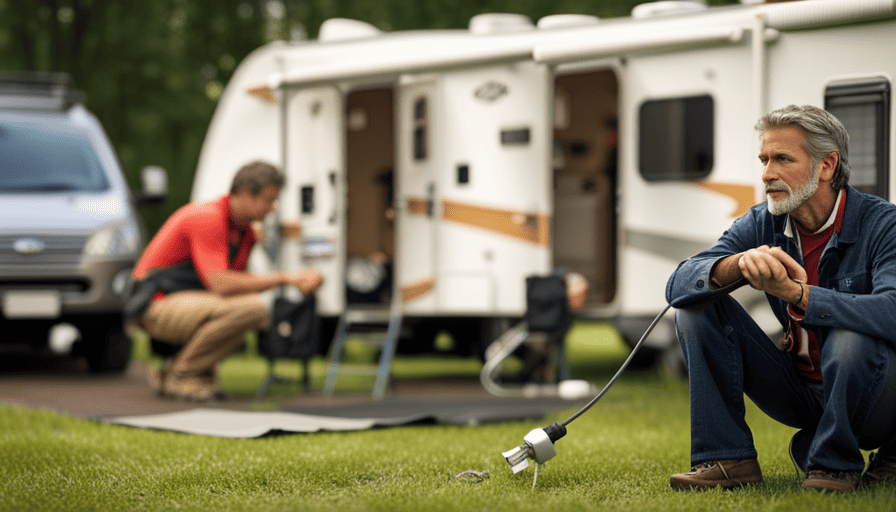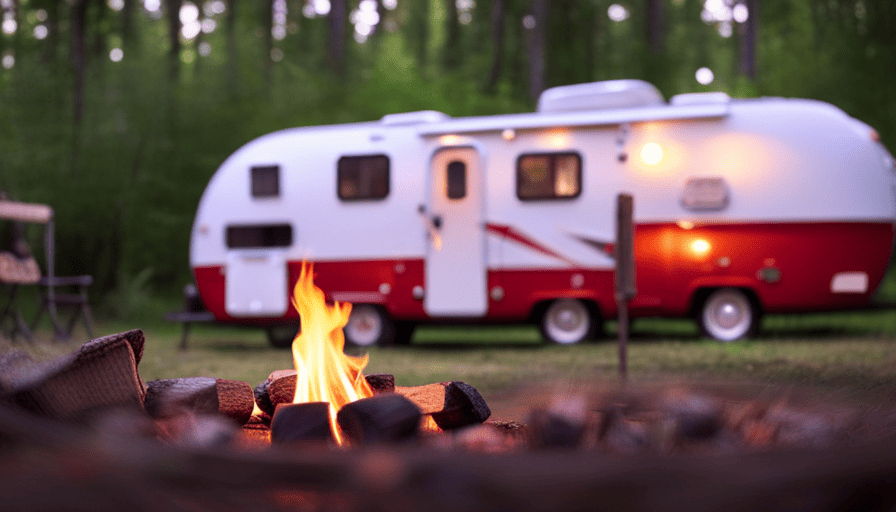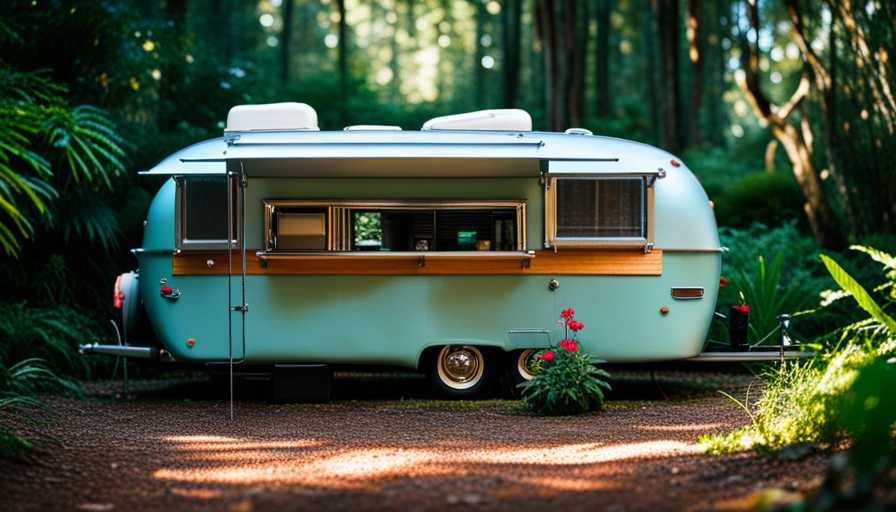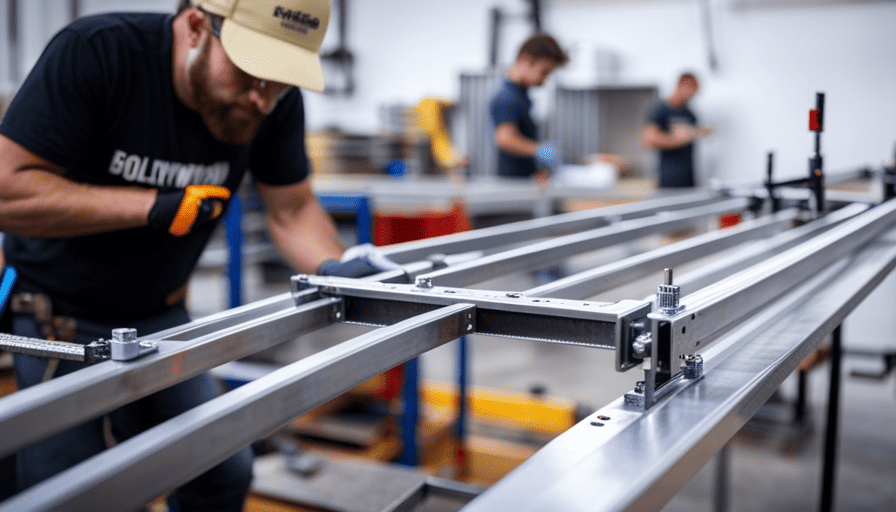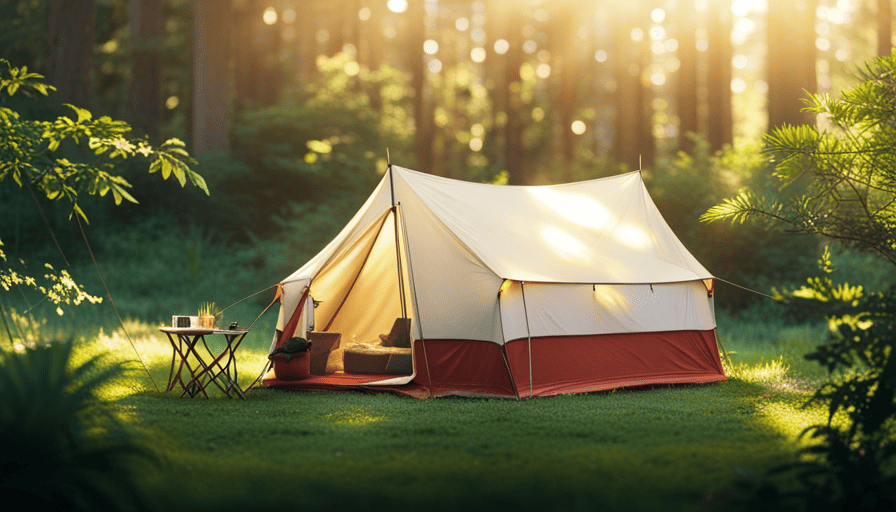Picturing this scene: You are deep in a camping adventure, enveloped by nature’s grandeur, encircled by majestic trees and stunning vistas. The quiet is only interrupted by the gentle crackle of a fire and sporadic bird calls. When the sun dips below the horizon and it starts to cool, you find yourself needing to warm up your camper. However, you face a challenge – there’s no electricity available.
Don’t worry, because I’ve got you covered. In this article, I will guide you through various methods of heating your camper without electricity. From propane heaters to wood-burning stoves, catalytic heaters to portable radiant heaters, I will provide you with practical solutions to keep you warm and cozy during those chilly nights.
But that’s not all. I’ll also share tips on using hot water bottles, thermal blankets, and reflective window covers to maximize insulation and retain heat. And for the eco-conscious campers out there, I’ll even explore alternative energy sources that can power your camper’s heating system.
So, whether you’re a seasoned camper or just starting out, get ready to learn some valuable techniques to keep your camper warm and comfortable, even in the absence of electricity.
Let’s dive in!
Key Takeaways
- Propane heaters, wood-burning stoves, catalytic heaters, and portable radiant heaters are suitable options for heating a camper without electricity.
- Proper insulation and weatherproofing, including the use of hot water bottles, thermal blankets, reflective window covers, and insulating curtains, are essential for retaining heat and increasing energy efficiency.
- Consider alternative energy sources such as solar power and wind power for sustainable and efficient heating solutions.
- Each heating method has its advantages and factors to consider, such as size, heat output, ventilation, safety features, portability, availability, fuel efficiency, and maintenance requirements.
Propane Heaters
Propane heaters are a convenient option for heating a camper without electricity. They’re portable and easy to use, making them a popular choice among campers. One type of propane heater commonly used in campers is the catalytic heater. These heaters use a chemical reaction to produce heat, making them efficient and safe to use indoors. They’re also known for their low maintenance requirements and long lifespan.
Another option for heating a camper without electricity is a diesel heater. They’re powered by diesel fuel, which is readily available in most places. They’re known for their high heat output and fuel efficiency, making them ideal for campers who spend a lot of time in cold climates. Diesel heaters are also easy to operate and can be controlled using a thermostat. In addition, diesel heaters produce dry heat, which can help reduce condensation inside the camper. This can be particularly beneficial for campers who are worried about moisture issues in their living space. While diesel heaters are a great option for off-grid heating, they can be a bit more expensive upfront compared to electric camper heating options. However, the long-term fuel savings and powerful heating capabilities often make them well worth the investment for frequent campers.
Transitioning to the next section about wood-burning stoves, it’s important to note that while propane and diesel heaters provide convenient heating solutions, they require a constant fuel source. Wood-burning stoves, on the other hand, offer a more sustainable heating option as they use wood as fuel. Let’s explore this alternative in more detail.
Wood-Burning Stoves
When it comes to choosing the right wood-burning stove for your camper, there are a few key factors to consider. It’s important to make sure the stove is the appropriate size for your space and has a good heat output.
Additionally, proper ventilation and safety precautions are crucial to prevent any potential fire hazards.
Lastly, using a wood-burning stove in your camper can have several benefits, such as providing a cozy and warm atmosphere, reducing reliance on electricity, and even allowing you to cook meals on top of the stove.
Choosing the right wood-burning stove
To efficiently heat a camper without electricity, one option is to invest in a wood-burning stove that suits your needs. When choosing a wood-burning stove, it is important to consider factors such as size, heat output, and installation requirements. To help you make an informed decision, I have created a comparison table below:
| Stove Model | Size (inches) | Heat Output (BTU) | Installation Requirements |
|---|---|---|---|
| Model A | 20x15x12 | 10,000 | Requires chimney |
| Model B | 18x10x14 | 8,000 | Can be installed with or without chimney |
| Model C | 24x20x16 | 12,000 | Requires professional installation |
Once you have chosen the right stove, proper installation is crucial to ensure safety and efficiency. It is recommended to hire a professional for wood-burning stove installation, as they can properly connect the stove to the chimney and ensure proper ventilation. Additionally, regular maintenance, such as cleaning the stove and chimney, is important to prevent creosote buildup and maintain optimal performance. By taking these precautions, you can enjoy a cozy and warm camper without electricity. Next, let’s discuss proper ventilation and safety precautions.
Proper ventilation and safety precautions
Make sure you prioritize your safety by ensuring proper ventilation in your cozy wood-burning stove setup. Proper ventilation is crucial to prevent carbon monoxide buildup and ensure the air quality inside the camper remains safe.
First, make sure your stove is installed correctly and follow the manufacturer’s guidelines for venting. It’s important to have a chimney that extends above the roofline to ensure proper airflow. Additionally, consider installing a carbon monoxide detector inside your camper for added safety.
When using the wood-burning stove, open a window slightly to allow fresh air to enter and create a draft. This will help maintain good airflow and prevent the buildup of harmful gases.
By following these ventilation safety measures and proper heating techniques, you can enjoy the cozy warmth of your wood-burning stove without compromising your safety.
Now, let’s explore the benefits of using wood-burning stoves.
Benefits of using wood-burning stoves
Imagine the crackling sound of burning logs and the comforting glow of a wood-burning stove, enveloping you in a cozy embrace as you revel in the timeless warmth it provides. When it comes to heating a camper without electricity, choosing the right wood-burning stove is crucial.
Look for a stove that’s compact, efficient, and specifically designed for use in small spaces like campers. Proper ventilation and safety precautions are essential when using a wood-burning stove. Make sure your camper has a working carbon monoxide detector and always ensure there’s adequate airflow to prevent the build-up of harmful gases.
Additionally, keep flammable materials away from the stove and practice safe fire management.
Transitioning into the subsequent section about catalytic heaters, it’s important to explore alternative heating options that can provide warmth without the need for a traditional wood-burning stove.
Catalytic Heaters
When you’re out in the wilderness, a catalytic heater can be your best friend for keeping warm in your camper without needing electricity. Catalytic heaters are a popular choice among campers due to their efficiency and convenience. These heaters use a catalytic reaction to convert propane into heat, providing a reliable source of warmth.
When choosing the right catalytic heater for your camper, there are a few factors to consider. Firstly, you need to assess the size of your camper and the heating capacity of the heater. It’s important to choose a heater that can effectively heat your space without wasting energy. Additionally, consider the safety features of the heater, such as automatic shut-off in case of tipping or low oxygen levels.
One of the advantages of propane heaters is their portability. Propane is readily available and can be easily transported in small canisters, making it ideal for camping trips. Moreover, propane heaters are efficient and can provide a consistent source of heat for extended periods of time.
Catalytic heaters are a practical and efficient way to heat your camper without electricity. By choosing the right heater and taking necessary safety precautions, you can enjoy a warm and cozy camping experience. Now, let’s transition into the next section about diesel heaters and explore another option for heating your camper.
Diesel Heaters
Diesel heaters, a popular alternative to catalytic heaters, are known for their high efficiency and long-lasting heating capabilities. Some models can provide warmth for up to 24 hours on a single tank of fuel. One of the advantages of diesel heaters is their low maintenance requirements. Regular maintenance primarily involves cleaning the fuel filter and checking the combustion chamber for any debris. It’s important to follow the manufacturer’s instructions regarding maintenance intervals and procedures to ensure optimal performance.
In addition to their efficiency, diesel heaters offer several other benefits. They’re relatively inexpensive to operate compared to other heating options, as diesel fuel is generally cheaper than propane or electricity. Diesel heaters also produce a consistent and steady flow of heat, ensuring a comfortable living environment in the camper. Another advantage is the fuel efficiency of diesel heaters, allowing campers to extend their heating time without the need for frequent refueling.
Now, let’s move on to the next section about portable radiant heaters, which offer a different approach to heating a camper without electricity.
Portable Radiant Heaters
When it comes to heating a camper without electricity, one option to consider is using a portable radiant heater. There are different types of portable radiant heaters available, such as propane and kerosene heaters, which can provide efficient and reliable heat.
However, it’s important to follow some tips for using these heaters safely, such as ensuring proper ventilation and keeping flammable materials away.
While portable radiant heaters can be a convenient heating solution, they also have their pros and cons. They offer portability and easy operation, but they also require a fuel source and come with potential safety risks.
Types of portable radiant heaters
To keep your camper cozy and warm without relying on electricity, one great option is using a portable radiant heater. These heaters offer several benefits for campers. Firstly, they provide instant heat, making them perfect for quickly warming up your space. Secondly, they are highly efficient, as they directly warm objects and people instead of wasting energy on heating the air.
When installing a radiant heater in your camper, there are a few considerations to keep in mind. Ensure that the heater is properly ventilated to prevent the buildup of carbon monoxide. Additionally, choose a heater that is compact and lightweight for easy portability.
With these installation considerations in mind, you can enjoy the warmth and comfort of a portable radiant heater in your camper.
Now, let’s move on to some tips for using these heaters effectively.
Tips for using portable radiant heaters
Now that we have discussed the different types of portable radiant heaters, let’s talk about some tips for using them effectively. When using a portable radiant heater, it is important to ensure that the camper’s flooring is properly insulated to prevent heat loss. This can be achieved by using rugs or floor mats to cover any exposed areas. Additionally, it is worth considering electric radiant heaters as they don’t require any fuel and can be a safer option for indoor use. These heaters use electricity to generate heat and distribute it evenly throughout the space. To get the most out of your electric radiant heater, make sure to position it in a central location and keep the surrounding area clear of any obstructions. By following these tips, you can maximize the efficiency and effectiveness of your portable radiant heater. In the next section, we will discuss the pros and cons of using these heaters in more detail.
Pros and cons of portable radiant heaters
Portable radiant heaters can be a total game-changer, giving you the power to transform any chilly space into a cozy oasis. These heaters are a popular choice for heating campers without electricity because of their convenience and versatility.
One of the biggest advantages of portable radiant heaters is that they’re compact and easy to transport, making them perfect for camping trips. They also provide quick and efficient heat, which is essential when you’re trying to stay warm in a camper.
However, it’s important to consider some drawbacks. Portable electric heaters require a power source, so they may not be suitable for all camping situations. Additionally, kerosene heaters can be a good alternative, but they require proper ventilation and can pose a safety risk if not used correctly.
Transitioning into the next section about insulation and weatherproofing, it’s crucial to address these aspects to maximize the effectiveness of any heating method.
Insulation and Weatherproofing
When it comes to camping, insulation is a crucial factor in keeping the camper warm and comfortable. Insulation materials like foam, fiberglass, and reflective barriers help to trap heat inside and prevent it from escaping.
Additionally, weatherproofing strategies such as sealing gaps, using weatherstripping, and insulating windows and doors can help to keep the camper dry and protect it from the elements.
Importance of insulation in campers
To keep warm in your camper, it’s crucial that you prioritize insulation. Proper insulation techniques and weatherproofing strategies are essential for maintaining a comfortable temperature inside your camper. Here are a few reasons why insulation is so important:
-
Heat retention: Insulation helps to trap heat inside the camper, preventing it from escaping and keeping the interior warm.
-
Energy efficiency: By insulating your camper, you can reduce the amount of energy needed to heat it, leading to lower energy costs.
-
Condensation prevention: Insulation also helps to prevent condensation from forming on the interior walls, which can lead to dampness and mold.
By focusing on insulation, you can create a cozy and warm environment inside your camper, even without electricity.
In the next section, we will explore different insulation materials and techniques that you can use to effectively heat your camper.
Insulation materials and techniques
Now that we understand the importance of insulation in campers, let’s explore some insulation materials and techniques that can help keep our camper warm without electricity. When it comes to insulation, there are various options available, each with its own pros and cons. Some commonly used insulation materials include foam board, fiberglass, and spray foam. These materials can be applied to the walls, roof, and floor of the camper to prevent heat loss and maintain a comfortable temperature inside. Additionally, using curtains or thermal shades on windows can further enhance insulation by reducing heat transfer. By incorporating these insulation techniques and energy-efficient solutions, we can minimize heat loss and maximize the warmth inside our camper. So, now that we have a well-insulated camper, let’s move on to weatherproofing strategies that can help us combat the elements and keep our camper cozy in any weather condition.
Weatherproofing strategies for campers
Implementing effective weatherproofing strategies in your camper ensures that you can maintain a cozy and comfortable environment, regardless of the external conditions. One important aspect of weatherproofing is insulating your windows. This can be done by using insulating window film or thermal curtains to prevent heat loss through the glass.
Another option is to use draft stoppers or weatherstripping to seal any gaps or cracks around the windows, doors, and vents. These can be easily installed and make a significant difference in keeping the cold air out and the warm air in.
By properly weatherproofing your camper, you can create a barrier against the elements and make your heating efforts more efficient.
Now, let’s move on to the next section about hot water bottles and heating pads, which provide additional ways to keep warm without electricity.
Hot Water Bottles and Heating Pads
Imagine snuggling up in your cozy camper with the comforting warmth of hot water bottles and heating pads. These two simple and affordable solutions can make a significant difference in keeping your camper warm without the need for electricity.
Hot water bottles are a classic method for staying warm during cold nights. Simply fill them with hot water from a stove or campfire, and they’ll provide hours of gentle heat. Place them under your blankets or at the foot of your bed to keep your sleeping area nice and toasty.
Heating pads are another great option. They’re portable and can be easily powered using batteries or propane. Simply switch them on and place them wherever you need extra warmth, whether it’s under your feet or against your back while sitting on the couch.
To make the most of hot water bottles and heating pads, here are some tips:
- For hot water bottles, wrap them in a towel or cloth before placing them in your bed to avoid direct contact with your skin.
- Consider using fleece or insulated covers for your hot water bottles to prolong their heat retention.
- Use heating pads with adjustable temperature settings to customize your comfort level.
Now, let’s move on to the next section about thermal blankets and sleeping bags. These items are essential for trapping body heat and ensuring a cozy night’s sleep in your camper.
Thermal Blankets and Sleeping Bags
When it comes to choosing the right thermal blanket for camping, I always look for one that’s lightweight and compact, yet still provides enough warmth.
Thermal sleeping bags are another great option to consider, as they offer insulation and comfort during cold nights.
To maximize warmth, I always make sure to layer my thermal blanket inside the sleeping bag, and I also use a sleeping pad for added insulation from the ground.
Choosing the right thermal blankets
To effectively heat your camper without electricity, you can choose the right thermal blankets that’ll keep you warm and cozy throughout the night. For instance, using a high-quality down-filled thermal blanket can provide excellent insulation and retain heat efficiently. These blankets are designed to trap your body heat and prevent it from escaping, creating a warm and comfortable environment inside your camper.
Additionally, there are DIY thermal blankets available that you can make using materials like Mylar or emergency blankets. These insulation alternatives can be cost-effective and provide good heat retention.
Now that you’ve chosen the right thermal blankets, let’s explore the benefits of using thermal sleeping bags for even more warmth and comfort during your camping adventures.
Benefits of using thermal sleeping bags
By utilizing thermal sleeping bags, you can enhance your camping experience with added warmth and comfort that goes beyond traditional methods. When it comes to winter camping essentials, thermal sleeping bags are a must-have. Here are three benefits of using thermal sleeping bags:
-
Superior Insulation: Thermal sleeping bags are designed to provide excellent insulation, trapping your body heat inside and keeping the cold air out. This ensures that you stay warm and cozy throughout the night, even in freezing temperatures.
-
Lightweight and Portable: Unlike bulky blankets or heavy sleeping bags, thermal sleeping bags are lightweight and easy to carry. They can be compressed into a small size, making them convenient for backpacking trips or any outdoor adventure.
-
Versatile Use: Thermal sleeping bags are not only great for camping but can also be used for other activities like hiking, trekking, or emergency situations. They’re designed to withstand harsh weather conditions and provide maximum warmth.
By maximizing warmth with thermal blankets and sleeping bags, you can ensure a comfortable and cozy camping experience.
Tips for maximizing warmth with thermal blankets and sleeping bags
One effective way to maximize warmth during your camping trip is by utilizing the insulation provided by thermal blankets and sleeping bags. These essential camping gear items are designed to trap and retain body heat, keeping you warm and comfortable throughout the night.
To further enhance the insulation, you can also use insulating curtains to block out any drafts and maintain a cozy interior temperature. Additionally, electric heating pads can be a great resource to provide targeted warmth to specific areas, such as your feet or back. By strategically placing these pads under your thermal sleeping bag or blanket, you can ensure that you stay warm even in colder weather.
Transitioning into the next section about reflective window covers, another effective way to maximize warmth in your camper is by using these covers to retain heat and insulate the interior.
Reflective Window Covers
Reflective window covers can significantly reduce heat loss in a camper, with studies showing that they can increase the interior temperature by up to 10 degrees Fahrenheit. These covers act as a barrier, preventing heat from escaping through the windows and keeping the cold air outside.
Here are three reasons why reflective window covers are a practical solution for heating a camper without electricity:
-
Insulating curtains: Reflective window covers are often made with insulating materials that have a high thermal resistance. This means that they can effectively trap heat inside the camper, preventing it from escaping through the windows. By using these covers, you can create a cozy and warm environment inside your camper, even in cold weather.
-
Reflective insulation: The reflective coating on these covers works by reflecting heat back into the camper. This helps to maintain a comfortable temperature inside, even when the outside temperatures are freezing. By reflecting the heat back, the covers minimize heat loss and keep the interior warm for longer periods.
-
Easy installation: Reflective window covers are typically lightweight and easy to install. Most covers come with suction cups or adhesive strips that allow you to attach them to the windows effortlessly. This means that you can quickly put them up when needed and take them down when you want to let in natural light.
By using reflective window covers, you can maximize the warmth in your camper without relying on electricity. However, if you’re looking for alternative energy sources to heat your camper, there are several options available.
Alternative Energy Sources
When it comes to heating campers without electricity, alternative energy sources can be a game-changer. Solar power is a popular option for campers, providing a sustainable and efficient way to heat your camper.
Additionally, wind power options are also available, allowing you to harness the power of the wind to generate heat. However, it’s important to consider the pros and cons of these alternative energy sources, such as cost, availability, and efficiency, before making a decision on how to heat your camper.
Solar power for heating campers
To keep your camper warm without electricity, you can rely on solar power to generate the heat needed for a cozy and comfortable camping experience.
One way to harness solar power is by installing solar panels on the roof of your camper. These panels will absorb sunlight and convert it into electricity, which can then be used to power a solar heating system. Solar heating systems typically consist of a solar collector, which absorbs the sun’s heat, and a heat exchanger, which transfers that heat to the air or water inside your camper. This system can provide a consistent source of heat throughout your camping trip, without the need for traditional electrical power.
Transitioning into the subsequent section about wind power options for campers, another alternative energy source for heating, wind power offers a sustainable and efficient solution.
Wind power options for campers
Looking to keep your camper warm in an eco-friendly way? Consider harnessing the power of wind for efficient heating options. Wind power is a great alternative energy source that can be used to generate electricity and heat for your camper. One option is to install a wind turbine on your camper’s rooftop. These turbines convert wind energy into electrical power, which can then be used to run a heater or a small electric furnace. Another option is to use portable solar panels in conjunction with a wind turbine. This combination allows you to maximize your energy production by using both wind and solar power. The solar panels can capture sunlight during the day, while the wind turbine can generate electricity during windy nights. This dual approach ensures that you have a constant source of power for heating your camper. In the next section, we will explore the pros and cons of alternative energy sources for camper heating.
Pros and cons of alternative energy sources for camper heating
Now that we’ve explored wind power options for campers, let’s dive into the pros and cons of alternative energy sources for camper heating, specifically focusing on solar power and comparing it to wind power.
Solar power has many benefits when it comes to heating a camper. Firstly, it’s a clean and renewable source of energy, meaning that it has a minimal impact on the environment. Additionally, solar panels are relatively easy to install and maintain, making them a practical choice for camper owners.
However, there are a few drawbacks to consider. Solar power relies on sunlight, so if you’re camping in a location with limited sun exposure, it may not be the most efficient option. Furthermore, solar panels can be expensive upfront, although they can save you money in the long run.
When comparing solar power to wind power options, it’s important to consider your specific camping needs and location to determine which alternative energy source is the most suitable for your camper heating system.
Frequently Asked Questions
Are there any safety precautions to consider when using propane heaters in a camper?
When using propane heaters in a camper, it’s crucial to follow safety precautions. First, ensure proper ventilation to prevent carbon monoxide buildup.
Regular maintenance of the propane heater is also essential. Check for any leaks or damaged components before use.
It’s important to have a carbon monoxide detector and a fire extinguisher on board.
Lastly, never leave the heater unattended and keep flammable materials away from it.
Following these precautions will help ensure a safe and warm camper experience.
How long can a wood-burning stove provide heat before needing to be refueled?
Wood-burning stoves can provide heat for a considerable amount of time before needing to be refueled. The longevity of a wood-burning stove depends on various factors such as the size of the stove, the type of wood used, and the temperature setting. Generally, a well-maintained wood-burning stove can provide heat for several hours before requiring more fuel.
However, it’s always a good idea to have alternative heating methods for campers, such as portable propane heaters or electric heaters, in case the wood-burning stove runs out of fuel.
Can catalytic heaters be used safely in small enclosed spaces like a camper?
Yes, catalytic heaters can be used safely in small enclosed spaces like a camper. These heaters are known for their efficiency in providing heat without electricity. They utilize a catalytic combustion process to convert fuel into heat, making them a reliable alternative heating option.
However, it’s important to ensure proper ventilation and follow manufacturer’s instructions for safe usage. Other alternative heating options for a camper without electricity include propane heaters, diesel heaters, and portable wood-burning stoves.
What are the advantages and disadvantages of using diesel heaters in a camper?
Advantages of using diesel heaters in a camper include efficient heating, as they can quickly warm up the space and maintain a consistent temperature. They’re also cost-effective, as diesel fuel is generally cheaper than other fuel options.
However, there are some disadvantages to consider. Diesel heaters can be noisy, which may be disruptive in a small enclosed space like a camper. Additionally, they require a separate fuel source and proper ventilation to avoid carbon monoxide buildup.
Can portable radiant heaters effectively heat a camper during extremely cold weather conditions?
Yes, portable electric heaters can effectively heat a camper during extremely cold weather conditions. They provide a convenient and efficient alternative to traditional heating methods. These heaters are compact, lightweight, and easy to transport, making them ideal for camping trips. They generate heat through radiant or convection methods, ensuring even distribution of warmth throughout the camper. With proper insulation and ventilation, portable electric heaters can keep you cozy and comfortable in freezing temperatures.
Are the Methods for Heating a Pop Up Camper the Same for Regular Campers?
Are the heating options for pop up campers the same as those for regular campers? Depending on the model, heating methods can vary. Regular campers often have built-in heating systems, whereas pop up campers usually rely on portable options like propane heaters or electric space heaters. It’s essential to consider the specific needs of your camper when deciding on the most suitable heating method.
Conclusion
In conclusion, when it comes to heating a camper without electricity, the possibilities are as vast as the open road. From the comforting warmth of a crackling wood-burning stove to the efficient and reliable propane heaters, there are options to suit every adventurer’s needs.
Don’t let the chill of the night hinder your travels; embrace the cozy embrace of a thermal blanket, the soothing heat of a hot water bottle, and the radiant glow of a portable heater. With these alternative energy sources, you can conquer any cold front and turn your camper into a haven of warmth and comfort.
So, get ready to hit the road and experience the joy of camping, even in the coldest of weather!


